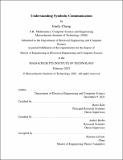Understanding Symbolic Communication
Author(s)
Cheng, Emily
DownloadThesis PDF (1.816Mb)
Advisor
Katz, Boris
Barbu, Andrei
Terms of use
Metadata
Show full item recordAbstract
We quantitatively study the emergence of symbolic communication in humans with a communication game that attempts to recapitulate an essential step in the development of human language: the emergence of shared abstract symbols in order to accomplish complex tasks. In our experimental setup, a teacher must communicate an abstract notion, a formula in first order logic rendered to them in natural language, to a student. Subjects do so through a narrow channel that deprives them of common shared symbols: they cannot see or speak to one another and must only communicate via the motions of cars in a computer game. We observe that subjects spontaneously develop a shared vocabulary of car motions for task-specific concepts, such as “square” and “forall”, as well as for task-agnostic concepts such as “your turn”. We find that symbols are harder to establish than icons and indices, and that systematically, indices develop before icons, which develop before symbols. We characterize the conditions under which indices, icons, and symbols arise, and identify communicating in ambiguous game environments as the primary pressure for icon and symbol development.
Date issued
2022-02Department
Massachusetts Institute of Technology. Department of Electrical Engineering and Computer SciencePublisher
Massachusetts Institute of Technology